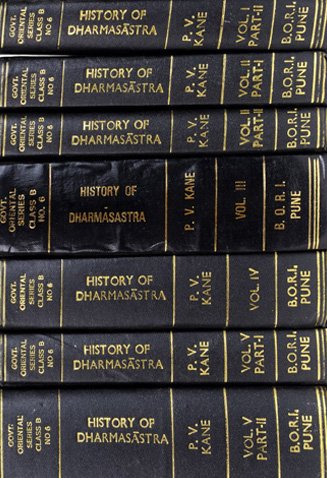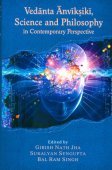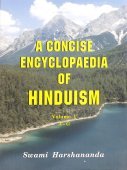Anvikshiki, Ānvīkṣikī, Ānvīkṣiki: 16 definitions
Introduction:
Anvikshiki means something in Hinduism, Sanskrit, Marathi. If you want to know the exact meaning, history, etymology or English translation of this term then check out the descriptions on this page. Add your comment or reference to a book if you want to contribute to this summary article.
The Sanskrit terms Ānvīkṣikī and Ānvīkṣiki can be transliterated into English as Anviksiki or Anvikshiki, using the IAST transliteration scheme (?).
In Hinduism
Dharmashastra (religious law)
Source: Wisdom Library: Dharma-śāstraĀnvīkṣikī (आन्वीक्षिकी) refers to “logic/philosophy”. It represents a branch of knowledge, dealing with the knowledge of the self, of which the King should be familiar with. The word is used throughout Dharmaśāstra literature such as the Manusmṛti. (also see the Manubhāṣya verse 7.43)
Source: Knowledge Traditions & Practices of India: Education: Systems & PracticesĀnvīkṣikī (आन्वीक्षिकी, “logic”) refers to one of the nine divisions of the Paurūṣeya classification of Śāstra knowledge; all part of the ancient Indian education system, which aimed at both the inner and the outer dimension of a person.

Dharmashastra (धर्मशास्त्र, dharmaśāstra) contains the instructions (shastra) regarding religious conduct of livelihood (dharma), ceremonies, jurisprudence (study of law) and more. It is categorized as smriti, an important and authoritative selection of books dealing with the Hindu lifestyle.
Purana and Itihasa (epic history)
Source: Cologne Digital Sanskrit Dictionaries: The Purana IndexĀnvīkṣiki (आन्वीक्षिकि).—(adhyātmakī vidyā)—Taught by Dattātreya to Alarka and others.1 Produced by Brahmā.2 Helps concentration on the Absolute.3 Learnt by Rāma and Kṛṣṇa.4 Symbolical of Devī.5
- 1) Bhāgavata-purāṇa I. 3. 11; Matsya-purāṇa 215. 54; Viṣṇu-purāṇa V. 10. 27.
- 2) Bhāgavata-purāṇa III. 12. 44; 25. 4.
- 3) Ib. XI. 20. 24.
- 4) Ib. X. 45. 34.
- 5) Viṣṇu-purāṇa I. 9. 121.

The Purana (पुराण, purāṇas) refers to Sanskrit literature preserving ancient India’s vast cultural history, including historical legends, religious ceremonies, various arts and sciences. The eighteen mahapuranas total over 400,000 shlokas (metrical couplets) and date to at least several centuries BCE.
Arthashastra (politics and welfare)
Source: Knowledge Traditions & Practices of India: Society State and Polity: A SurveyĀnvīkṣikī (आन्वीक्षिकी) refers to “philosophy and logic” and represents one of the four classes of knowledge needed to run a state according to Kauṭilya’s Arthaśāstra (4th century BCE): one of the most influential treatises of political science. Ānvīkṣikī is considered to be the “lamp of all sciences”.

Arthashastra (अर्थशास्त्र, arthaśāstra) literature concerns itself with the teachings (shastra) of economic prosperity (artha) statecraft, politics and military tactics. The term arthashastra refers to both the name of these scientific teachings, as well as the name of a Sanskrit work included in such literature. This book was written (3rd century BCE) by by Kautilya, who flourished in the 4th century BCE.
General definition (in Hinduism)
Source: Shodhganga: A study of Nyāya-vaiśeṣika categories (h)Ānvikṣikī (आन्विक्षिकी).— The oldest name of Nyāya is Ānvikṣikī. Ānvikṣikī means the science of inquiry. It comprises Ātma-vidyā and the theory of reasons. Manu has used the term Ānvikṣikī to mean Ātmavidyā and his followers also called Ānvīkṣikī as a branch of the Vedas.8 Kauṭilya has accepted Ānvīkṣikī as a separate branch of study over and above, Trayi (the Vedas), Vārttā (commerce) and Daṇḍanīti (polity). Kauṭilya has included the Sāṃkhya, Yoga and Lokāyata in the Ānvikṣikī.
The time of the formation of Ānvikṣikī as a distinct branch of learning was about 650 B.C. Ānvīkṣikī was called Hetu-śāstra or Hetu Vidyā as it dealt predominantly with the science of reasoning. This meaning of Ānvīkṣikī is found in the Manusaṃhitā, Mahābhārata etc. It is also known as Tarkavidyā, the art of debate or Vāda-vidyā, the art of discussion. In later times Ānvikṣikī has come to be denoted as Nyāya-śāstra (the science of true reasoning).
Languages of India and abroad
Marathi-English dictionary
Source: DDSA: The Molesworth Marathi and English Dictionaryānvīkṣikī (आन्वीक्षिकी).—f S The first of the four divisions of rājanīti (the science of kingly administration). Searching out or scheming and planning by consideration and consultation. See trayī, vārttā, daṇḍa- nīti. 2 Or ātmavidyā Science of spiritualities or spirit; science of principles, nature, or being; ontology, metaphysics, or general philosophy. ānvī- kṣikī is explained as comprehending nyāyaśāstra & vēdānta or Logical philosophy and the Philosophy of spirit. See arthaśāstra.
Source: DDSA: The Aryabhusan school dictionary, Marathi-Englishānvīkṣikī (आन्वीक्षिकी).—f (The first of the four divisions of rājanīti) Science of spiri- tuality.
Marathi is an Indo-European language having over 70 million native speakers people in (predominantly) Maharashtra India. Marathi, like many other Indo-Aryan languages, evolved from early forms of Prakrit, which itself is a subset of Sanskrit, one of the most ancient languages of the world.
Sanskrit dictionary
Source: DDSA: The practical Sanskrit-English dictionaryĀnvīkṣikī (आन्वीक्षिकी).—[anvīkṣā prayojanamasyāḥ ṭhañ]
1) Logic, logical philosophy.
2) Metaphysics (ātmavidyā q. v.); आन्वीक्षिक्यात्मविद्या स्यादीक्षणात्सुखदुःखयोः । ईक्षमाणस्तया तत्त्वं हर्षशोकौ व्युदस्यति (ānvīkṣikyātmavidyā syādīkṣaṇātsukhaduḥkhayoḥ | īkṣamāṇastayā tattvaṃ harṣaśokau vyudasyati) || Kām.2.11; आन्वीक्षिकीश्रवणाय (ānvīkṣikīśravaṇāya) Mālatīmādhava (Bombay) 1; Manusmṛti 7.43; (nyāya ānvīkṣikī pañcādhyāyī gautamena praṇītā Madhusūdhana).
3) Philosophy of Sāṅkhya, Yoga and Lokāyata; साङ्ख्यं योगो लोकायतं चेत्यान्वीक्षिकी (sāṅkhyaṃ yogo lokāyataṃ cetyānvīkṣikī) Kau. A.1.2. cf. also आन्वीक्षिकी त्रयी वार्ता दण्डनीतिश्चेति विद्याः (ānvīkṣikī trayī vārtā daṇḍanītiśceti vidyāḥ) Kau. A.1.2. आश्रयः सर्वधर्माणां शश्वदान्वीक्षिकी मता (āśrayaḥ sarvadharmāṇāṃ śaśvadānvīkṣikī matā) Kau. A.1.2; Bhāgavata 7.12.23.
Source: Cologne Digital Sanskrit Dictionaries: Shabda-Sagara Sanskrit-English DictionaryĀnvīkṣikī (आन्वीक्षिकी).—f. (-kī) Logical philosophy, metaphysics. E. anu according to, īkṣ to see, ṭhak aff.
Source: Cologne Digital Sanskrit Dictionaries: Cappeller Sanskrit-English DictionaryĀnvīkṣikī (आन्वीक्षिकी).—(±vidyā) [feminine] logic.
Source: Cologne Digital Sanskrit Dictionaries: Monier-Williams Sanskrit-English Dictionary1) Ānvīkṣikī (आन्वीक्षिकी):—f. ([from] anv-īkṣā), logic, logical philosophy, metaphysics, [Mahābhārata; Manu-smṛti; Gautama-dharma-śāstra etc.]
2) (also, with buddhi) an argumentative mind, [Rāmāyaṇa]
Source: Cologne Digital Sanskrit Dictionaries: Yates Sanskrit-English DictionaryĀnvīkṣikī (आन्वीक्षिकी):—(kī) 3. f. Metaphysics.
[Sanskrit to German]
Sanskrit, also spelled संस्कृतम् (saṃskṛtam), is an ancient language of India commonly seen as the grandmother of the Indo-European language family (even English!). Closely allied with Prakrit and Pali, Sanskrit is more exhaustive in both grammar and terms and has the most extensive collection of literature in the world, greatly surpassing its sister-languages Greek and Latin.
Kannada-English dictionary
Source: Alar: Kannada-English corpusĀnvīkṣiki (ಆನ್ವೀಕ್ಷಿಕಿ):—[noun] the science and art of critical thinking; logical philosophy; logics.
Kannada is a Dravidian language (as opposed to the Indo-European language family) mainly spoken in the southwestern region of India.
Nepali dictionary
Source: unoes: Nepali-English DictionaryĀnvīkṣikī (आन्वीक्षिकी):—n. 1. logic; logical philosophy; 2. metaphysics; 3. spiritual science;
Nepali is the primary language of the Nepalese people counting almost 20 million native speakers. The country of Nepal is situated in the Himalaya mountain range to the north of India.
See also (Relevant definitions)
Full-text: Tarkavidya, Atmavidya, Vamshadhara mishra, Adhyatmakividya, Kulavidya, Rajaniti, Ashtavidya, Vartta, Dandaniti, Vidya, Khyati, Trayi, Paurusheya, Arthashasna, Atri, Nyayasutra.
Relevant text
Search found 35 books and stories containing Anvikshiki, Ānvīkṣikī, Ānvīkṣiki, Anviksiki; (plurals include: Anvikshikis, Ānvīkṣikīs, Ānvīkṣikis, Anviksikis). You can also click to the full overview containing English textual excerpts. Below are direct links for the most relevant articles:
The Concept of Sharira as Prameya (by Elizabeth T. Jones)
The Nyāya philosophy < [Chapter 1]
Introduction to Indian Philosophy < [Chapter 1]
Concept of Prameyas (objects of Right Knowledge) < [Chapter 2]
Manusmriti with the Commentary of Medhatithi (by Ganganatha Jha)
Verse 7.43 < [Section IV - Duties of the King]
Nyaya-Vaisheshika categories (Study) (by Diptimani Goswami)
Historical Survey of Nyāya System < [Chapter 1 - Introduction]
A History of Indian Philosophy Volume 1 (by Surendranath Dasgupta)
Part 2 - Nyāya and Vaiśeṣika sūtras < [Chapter VIII - The Nyāya-Vaiśeṣika Philosophy]
Amarakoshodghatana of Kshirasvamin (study) (by A. Yamuna Devi)
Education (6): Literature < [Chapter 4 - Cultural Aspects]
Education (4): Language and literature < [Chapter 4 - Cultural Aspects]
Philosophy (3): Nyāya and Vaiśeṣika < [Chapter 4 - Cultural Aspects]
Philosophy of Charaka-samhita (by Asokan. G)
The historicity of logic and dialectical speculations of Carakasaṃhitā < [Chapter 7 - Logic and Dialectical Speculations]
Knowledge (pramāṇa) [in Charaka philosophy] < [Chapter 6 - Source of Knowledge (pramāṇa)]
Related products

